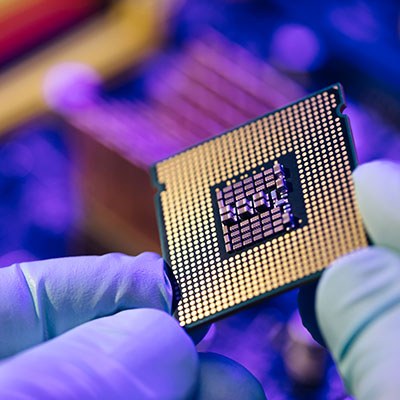Published: September 30, 2022

Semiconductors. Everyone uses them, but how many of us really know what they are, what they do, and the increasingly important role they play in our modern world? Much like supply chains, artificial intelligence and other O.R. buzzwords that are making their way into the public conscious, semiconductor is a term that most of us have probably heard, but their actual significance might remain a bit of a mystery.
And perhaps even less well known are the challenges associated with their manufacturing, especially with the ongoing issues relating to supply chains, and alarmingly, the risk this could pose to national security.
In this episode I’m joined by Zachary Collier, professor with Radford University and a visiting scholar at the Center for Hardware and Embedded Systems Security and Trust (CHEST), to take a deep dive into all things semiconductor and tackle some of these questions and growing concerns.
There’s a concern that the supply to the U.S. could be cut off entirely by an unfriendly nation, leaving us without the chips that we need to power the things that make our economy run. Many semiconductors are produced in Taiwan and tensions in that region raise concerns about the potential for a Chinese invasion that could disrupt the global supply.
Interviewed this episode:

Zachary Collier
Radford University and the Center for Hardware and Embedded Systems Security and Trust (CHEST)
Zachary A. Collier is Assistant Professor in the Department of Management at Radford University. His research interests include Risk Analysis and Decision Analysis, which he applies to problems at the intersection of technological, organizational, and societal domains, with a special interest in the semiconductor supply chain. He currently serves as Co-Chair of the NDIA Electronics Division’s Trust and Assurance Committee. He is an active member of INFORMS, where he serves on the Advocacy Governance Committee. Dr. Collier is a Fellow of the Center for Risk Management of Engineering Systems at University of Virginia, a Visiting Scholar at the NSF Center for Hardware and Embedded Systems Security and Trust (CHEST), a member of the Society for Risk Analysis, and contributes as a subject matter expert to the development of industry standards through SAE International. His prior work experience includes the U.S. Army Engineer Research and Development Center, where he was a member of the Risk and Decision Science Team. He is Managing Editor of the Springer journal “Environment Systems & Decisions”, and is a member of the Editorial Board of “Risk Analysis”. He earned his Ph.D. in Systems Engineering from University of Virginia, a Master of Engineering Management from Duke University, and a Bachelor of Science in Mechanical Engineering from Florida State University.
Related Episodes
Episode Transcript
Semiconductors. Everyone uses them, but how many of us really know what they are, what they do, and the increasingly important role they play in our modern world. Much like supply chains, artificial intelligence, and other OR buzzwords that are making their way into the public conscious, semiconductor is a turn that most of us have probably heard, but their actual significance might remain a bit of a mystery.
And perhaps even less well known are the challenges associated with their manufacturing, especially with the ongoing issues relating to supply chains, and alarmingly, the risk this could pose to national security.
In this episode, I’m joined by Zachary Collier, professor with Radford University and a visiting scholar at the Center for Hardware and Embedded System Security and Trust, to take a deep dive into all things semiconductor and tackle some of these questions and growing concerns.
Zach, thank you for joining me. For me personally, I’m familiar with semiconductors and probably have a vague understanding of what their role is, and I know I’m probably not alone in this, so I’m excited to explore this topic today.
Zachary Collier:
Yeah, thanks for having me.
Ashley Kilgore:
So Zach, can you start us off by explaining what semiconductors are, what they do, and why they’re so important to our day-to-day lives?
Zachary Collier:
Yeah, sure. So you might remember from high school science class that some materials are classified as conductors, and others are insulators. And technically speaking, a semiconductor is really just any material that is somewhere between a conductor and an insulator. In practice, when people use the term semiconductors, they’re really talking about the chips that go into different things like computers and cell phones that are made out of semiconductor materials.
These chips are the brains of modern electronics. They enable all types of functions that are important to us, like the computing power in our phone and the memory. They’re important in our day to day lives because they power just about everything that we use, including things like our cars and our phones. And also they play an important role in a lot of critical industry sectors like healthcare, energy, finance, and defense.
Ashley Kilgore:
So then my next question is, what is the scope of the semiconductor industry, both regarding their production and their use?
Zachary Collier:
Right. So according to some estimates, semiconductors are the fourth most traded commodity in the world, right up there with oil. Semiconductors are around a 500 billion dollar global industry. The supply chain is global and highly fragmented because each of the steps required to make a semiconductor is highly specialized. It requires a lot of equipment and special skills.
Currently, the United States is the leader in semiconductor design, while Asia is currently the leader in manufacturing and assembly. The United States manufactures about 12% of the world’s semiconductors right now, while we consume somewhere between a quarter and a third of the global supply, depending on who you ask.
In general, demand for semiconductors is increasing, which has led to a global shortage that you’ve probably read about in the news. This has been accelerated by the Covid pandemic as people found themselves needing electronics to work from home. And it’s had ripple effects throughout the economy, including industries like car manufacturing that was hit particularly hard by the shortages.
Ashley Kilgore:
Zach, could you walk us through semiconductor production? What are some of the challenges associated with this?
Zachary Collier:
Yeah, sure. So the life cycle is extremely complex. It involves a lot of different players distributed across the globe to make a single chip. At a high level, the life cycle starts with design. Often, a company that designs the chip though, is not the one that actually manufactures it. That manufacturing is outsourced because manufacturing involves building and maintaining very large and expensive facilities with highly intricate and specialized equipment that costs billions of dollars to construct and operate. This has led to a lot of outsourcing over the years, primarily to countries in Asia that can manufacture the semiconductors more cost effectively, in part because many of these Asian countries highly subsidize that industry.
After the chips are manufactured, they go through additional steps including packaging, assembly, and testing, and then they end up in the particular products that we use.
Another important life cycle step that’s sometimes overlooked is disposal and end of life. Counterfeiting can actually occur when chips are harvested from electronic waste that’s thrown in the trash and sold back into the market as new.
Ashley Kilgore:
So if I understand correctly, we have these vital electronic components that are associated with the storage of some of our most sensitive personal information, that are not only produced in countries where security might be a concern, but also supply chain issues can impact our access to them. While it might already be pretty obvious, could you explain why semiconductors pose a risk to national security?
Zachary Collier:
So from a security standpoint, there’s several concerns to think about. One already mentioned is that of counterfeits, which may cause the product that they end up being inserted into to have degraded quality and functionality. More worrying is the design of the chip could be somehow adulterated to allow for the insertion of what we call Trojan horses that can secretly siphon off sensitive data or allow for unauthorized access to the system.
Another concern is intellectual property theft. When a chip designer hands off the design to a manufacturer, the designer runs the risk that the IP could be stolen.
And then finally, there’s a concern that the supply to the US could be cut off entirely by an unfriendly nation, leaving us without the chips that we need to power the things that make our economy run.
Many semiconductors are produced in Taiwan, and tensions in that region raise concerns about the potential for a Chinese invasion that could disrupt the global supply. Additionally, the Russia Ukraine conflict right now is another example that has impacted chip production, as much of the neon gas that’s used in semiconductor manufacturing comes from that region.
It really comes down to the fact that overdependence on foreign nations for such a critical resource puts the country in a really vulnerable situation.
Ashley Kilgore:
So Zach, here’s another question where I think the answer’s probably already pretty obvious. But why do semiconductors, more so than any of the other products manufactured overseas and imported into the US, pose such a significant security risk?
Zachary Collier:
Yeah, the defense sector in particular depends on a secure and trusted supply of semiconductors to enable a wider range of high tech, war fighting capabilities. Think about things like fighter jets and submarines, for example. These are applications that require high performance and high reliability.
One of the aspects of hardware security is what we call integrity. That roughly means that a component does what it’s supposed to do and doesn’t do what it’s not supposed to do. These defense applications require high integrity as well as confidentiality and availability.
In the case of national security and defense, we need semiconductors that come from a supply chain of trusted suppliers who can provide traceability into where components have been, and assurance that they meet the strictest security standards.
Ashley Kilgore:
So I can imagine that one of the biggest contributing factors to why we outsource the production of certain items overseas, especially electronics, has a lot to do with the cost of production labor. Is this feasibly something we could bring inside the US for manufacturing?
Zachary Collier:
Well, that’s certainly what Congress and the Biden administration are trying to do with the recent passage of the Chips and Science Act. The goal of the legislation that was passed recently is to encourage domestic research and manufacturing capabilities through around 52 billion in grants, tax incentives, and various programs aimed at offsetting the high cost of semiconductor production.
While the legislation just passed in August, we’ve already seen many leading chip makers indicating that they plan to start new construction of manufacturing facilities across the country. This is seen in the industry as a positive step in ensuring the United States’ share of manufacturing capacity doesn’t continue to drop relative to the rest of the world, and that we can maintain technological leadership on the global stage.
Ashley Kilgore:
Zach, thanks again so much for joining me today. I’d like to wrap up with the question, what do you think next steps are in regard to the concerns and risks associated with semiconductors? Where do we go from here?
Zachary Collier:
Yeah, so there are a number of things to think about moving forward, especially as the chips funding starts to be rolled out.
One thing to think about is the entire end to end ecosystem. While manufacturing is certainly important, we can’t ignore steps like packaging and assembly, which are almost exclusively performed overseas and are important for system security.
Another thing is to ensure that we build not only state-of-the-art chip capacity, but also capacity for older, more mature chip technologies that are currently used in many applications today.
Finally, it’s really important to think about focusing on building the semiconductor workforce to support this important industry by teaming up between academia, industry, and government to train the next generation of workers. And I think this is an area where INFORMS can play an important role.
Ashley Kilgore:
Want to learn more? Visit resoundinglyhuman.com for additional information on this week’s episode and guest. The podcast is also available for download or streaming from Apple Podcasts, Google Play, Stitcher, and Spotify. Wherever you listen, if you enjoy Resoundingly Human, please be sure to leave a review to help spread the word about the podcast. Until next time, I’m Ashley Kilgore, and this is Resoundingly Human.
Want to learn more? Check out the additional resources and links listed below for more information about what was discussed in the episode.
Chinese Invasion of Taiwan Could Undermine Global Semiconductor Market, Newsweek
Zachary Collier: Onshoring Semiconductor Capacity is Crucial to National Security, Florida Daily
Onshoring Semiconductor Capacity Is Crucial to National Security, Real Clear Politics
Risk management essential for strengthening global supply chain, EP&T


